#❛ opposite. ripley sullivan ❜
Explore tagged Tumblr posts
Text
tag dump !!!
❛ muse. character name ❜
❛ thread. character name ❜
❛ visage. character name ❜
❛ music. character name ❜
❛ opposite. opps name ❜
#❛ muse. lianne sinclair ❜#❛ thread. lianne sinclair ❜#❛ visage. lianne sinclair ❜#❛ music. lianne sinclair ❜#❛ opposite. prosper raffa ❜#❛ family. odelia raffa ❜#❛ family. arturo raffa ❜#❛ family. vincent raffa ❜#❛ muse. hank choi ❜#❛ thread. hank choi ❜#❛ visage. hank choi ❜#❛ music. hank choi ❜#❛ opposite. jamie parker ❜#❛ muse. isaac hampton ❜#❛ thread. isaac hampton ❜#❛ visage. isaac hampton ❜#❛ music. isaac hampton ❜#❛ opposite. ripley sullivan ❜#❛ family. myles sullivan ❜#❛ family. noah sullivan ❜
1 note
·
View note
Text
i’m pleasantly surprised that i didn’t hate the final, probably because not much had actually happened and the cliffhangers were quite weak
carina being super nervous and maya being totally chill while waiting was funny even if the complete opposite of how they’ve acted last episode (but we can’t really expect any sort of consistency in this show), i enjoyed the interview, carina telling the story of how they met and the beginning of their relationship was cute (i’m also glad it aligns with my headcanon for it) although there was a part where carina (and tbh also me a little bit) wanted to kill maya just so she could shut up (which was a bit uncharacteristic for her)
i’m so glad we don’t have any definitive answer about the pregnancy yet it opens so many doors for the writers to make this storyline better and interesting (most of my hopes are quite dark though). do i actually think they’ll go with an interesting storyline that they’ll handle with the care it deserves? absolutely no, but at least i don’t have to spend the next four months angry and annoyed
maya, maya, maya, she one hundred percent deserves to be captain and i’m on her side but that was such a stupid way to go about it and it will without a doubt backfire, she really should have talked to her wife about it first
elsewhere in the episode:
pru is very cute and i’m glad she seems happy but it’s quite funny how they’ve just completely dropped the millers demand for ben to stop being a firefighter (was jason’s contract up and they weren’t sure if he’s going to sign again but then he did? or just the usual writers disregard for their own storylines?)
i’m not a fan of travis running for mayor, mainly because i don’t want him to stop being at 19 and i also can’t stand dixon and i’m quite tired of keep seeing him. also i looked it up and the entire thing makes no sense, seattle is a very blue city (the last time the mayor of seattle was republican was 1970), also it seems like everyone is running without any affiliation to a party in the election (most of them do have affiliations in their wiki pages but not for the actual election for some reason) so dixon actually winning is ridiculous when you look at the city and its people
i’m also not sure what he hopes to achieve? does he want to be mayor or does he want to take votes from dixon and hope that two other (hopefully democratic) candidates will benefit from it and end up running against each other? because if it’s the latter then why won’t he just find ways to help one of their campaigns and help them beat dixon?
i really don’t care about ross and sullivan, what she’s doing is completely wrong and unprofessional and in a profession that has many life or death situations in it, it could also be dangerous (it actually highlights how better they’ve done a similar situation with vic and ripley)
i hope it means there’s no more beckett but what an anticlimactic way to get rid of him
jack is clearly going through something but i’m not really worried about him because he’ll be fine and he’ll be back, hopefully with his own storyline
this was quite long but i needed to write it so it’ll maybe leave my mind
#i'm looking forward to four months of relatively peace and quiet#station 19#maya bishop#carina deluca#maya x carina#ben warren#travis montgomery#station 19 spoilers
4 notes
·
View notes
Text
Chiappeavis magnapremaxillo
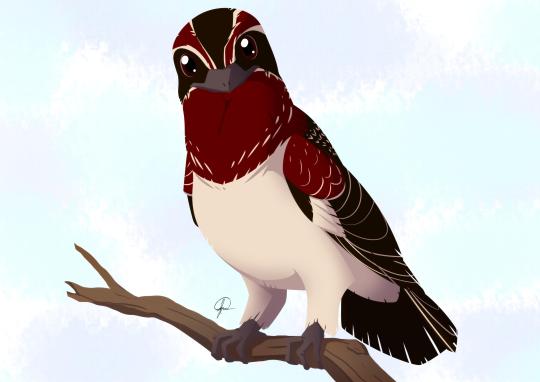
By José Carlos Cortés
Etymology: Chiappe’s Bird
First Described By: O’Connor et al, 2016
Classification: Dinosauromorpha, Dinosauriformes, Dracohors, Dinosauria, Saurischia, Eusaurischia, Theropoda, Neotheropoda, Averostra, Tetanurae, Orionides, Avetheropoda, Coelurosauria, Tyrannoraptora, Maniraptoromorpha, Maniraptoriformes, Maniraptora, Pennaraptora, Paraves, Eumaniraptora, Averaptora, Avialae, Euavialae, Avebrevicauda, Pygostaylia, Ornithothoraces, Enantiornithes, Cathayornithiformes
Status: Extinct
Time and Place: 120 million years ago, in the Aptian age of the Early Cretaceous

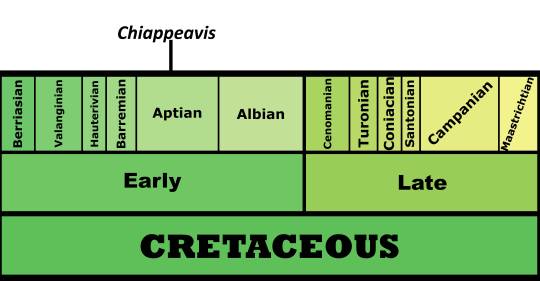
Chiappeavis is known from the Jiufotang Formation of China, specifically in the Shangheshou Beds

Physical Description: Chiappeavis was an Opposite Bird, ie the group of bird-like dinosaurs that were extremely diverse and widespread during the Cretaceous period. Chiappeavis is known from a nearly complete skeleton, including some feather impressions. It was a fairly large bird, probably around 20 or so centimeters (though this is a very rough estimate). It had a small snout, with small pointed teeth inside of it, and a fairly large head. Its body was long, and it had large wings - good for more powerful flying as opposed to tighter maneuvering in between trees. Interestingly enough, Chiappeavis had a giant tail fan, which was not actually universal among Opposite BIrds as it is in modern birds. It also had fairly thick, strong feet.
Diet: It is probable that Chiappeavis fed mainly on arthropods and other hard invertebrates.
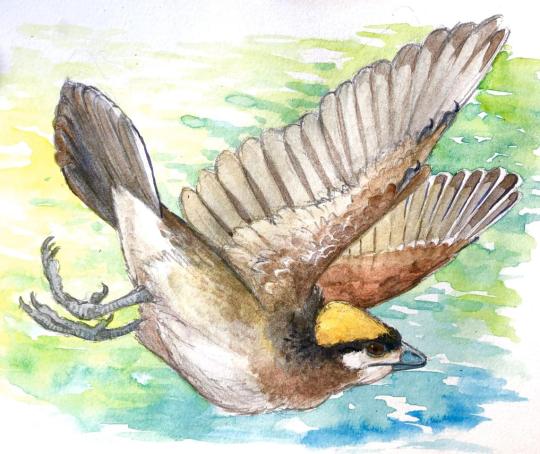
By Ripley Cook
Behavior: It is uncertain what the behavior of Chiappeavis was, given that we do not have extensive skeletons of this dinosaur. Still, it probably wouldn’t have flitted about the trees as much as birds with wings better built for maneuvering. The tail fan of Chiappeavis probably would have been extremely useful in sexual display, as well as other forms of communication - especially since it does not appear to have been very good at generating lift during flight (hence it not being widespread in other Opposite Birds). As such, it is more likely than not that Chiappeavis would have been fairly social, living in groups of multiple birds which communicated and recognized each other with feather displays. This, therefore, leads us to yet another likely hypothesis: that it took care of its young, at least to some extent. Beyond that, the behavior of Chiappeavis is a bit of a question - though it may have been able to dig out insects and other grubs with its strong feet, and then bit into the tough exteriors of these animals with its many needle-like teeth.
Ecosystem: The Jiufotang Formation was one of the Jehol Biota ecosystems, aka a group of extremely diverse and lush environments that preserved birdie dinosaurs of the Early Cretaceous with great detail. In that, Chiappeavis is one of many dinosaurs found in this location with extensive feather preservation. TheJiufotang Environment was a dense forest, surrounding an extensive number of lakes, and near volcanically active mountains. Still, it isn’t quite as well known as the earlier Yixian formation, and in fact doesn’t seem to have as many plants preserved to inform the exact environment and temperature. Still, it’s reasonable to suppose it may have also been a temperate ecosystem, like the earlier Yixian Formation, potentially even with snow.

By Jack Wood
In this environment, there were an extremely wide variety of animals. There was a decent diversity of fish, quite a few kinds of mammals, and the weird, unclassifiable Choristoderes were represented by Philydrosaurus, Ikechosaurus, and Liaoxisaurus. This ecosystem was lousy with pterosaurs, featuring a variety of Chaoynagopterids - like Chaoyangopterus itself, Eoazhdarcho, Jidapterus, and Shenzhoupterus; Pteranodonts like Guidraco, Ikrandraco, Liaoningopterus, Nurhachius, Liaoxipterus, and Linlongopterus; Tapejarids like “Huaxiapterus”, (probably) Nemicolopterus, and Sinopterus; and the weirdly late-surviving Anurognathid Vesperopterylus.
As for dinosaurs, there were many, and most were bird like! There was of course the Ankylosaur Chuanqilong, and the early Ceratopsian Psittacosaurus; there was also an unnamed titanosaur. There was a Tyrannosauroid, SInotyrannus, the Chickenparrot Similicaudipteryx, the raptor Microraptor, and tons of early Avialans like Confuciusornis, Dalianraptor, Jeholornis, Omnivoropteryx, Sapeornis, Shenshiornis, and Zhongjianornis. There were also “true” birds (ie, the line of dinosaurs that would evolve into those we see today) such as Bellulornis, Piscivoravis, Archaeorhynchus, Chaoyangia, Jianchangornis, Parahongshanornis, Schizooura, Songlingornis, Yanornis, and Yixianornis. However, the most diverse group of dinosaurs were the Opposite Birds, of which Chiappeavis was only one of many. There was Alethoalaornis, Boluochia, Bohaiornis, Cathayornis, Cuspirostrisornis, Dapingfangornis, Eocathayornis, Piscivorenantiornis, Pengornis, Gracilornis, Huoshanornis, Largirostrornis, Longchengornis, Longipteryx, Rapaxavis, Shangyang, Sinornis, and Xiangornis - just to name a few! As such the Jiufotange remains as a rich ecosystem in which to study the evolution of this fantastic group of Cretaceous dinosaurs.

By Scott Reid
Other: Chiappeavis is probably not its own thing - it is one of a number of Opposite Birds described without substantial evidence that it was a distinct genus and, indeed, many researchers consider them to be members of other genera. In this case, Chiappeavis is probably the same as Pengornis. Still, until it is officially lumped in, it must be treated as its own genus. It had a lot of similarities to Pengornis, regardless, indicating the two may belong to a larger clade of Opposite Birds. In short, Opposite Bird Phylogeny is kind of a mess, and needs a lot more intensive work than has currently been done.
~ By Meig Dickson
Sources Under the Cut
Czerkas, S. A., D. Zhang, J. Li and Y. Li. 2002. Flying dromaeosaurs. In S. J. Czerkas (ed.), Feathered Dinosaurs and the Origin of Flight. The Dinosaur Museum Journal 1. The Dinosaur Museum, Blanding, UT 96-126
Czerkas, S. A., and Q. Ji. 2002. A preliminary report on an omnivorous volant bird from northeast China. In S. J. Czerkas (ed.), Feathered Dinosaurs and the Origin of Flight. The Dinosaur Museum Journal 1. The Dinosaur Museum, Blanding, UT 127-135
Dong, Z.-M., Y.-W. Sun, and S.-Y. Wu. 2003. On a new pterosaur from the Lower Cretaceous of Chaoyang Basin, Western Liaoning, China. Global Geology 22:1-7
Dong, Z., and J. Lü. 2005. A new ctenochasmatid pterosaur from the Early Cretaceous of Liaoning Province. Acta Geologica Sinica 79(2):164-167
Dong, L., Y. Wang, and S. E. Evans. 2017. A new lizard (Reptilia: Squamata) from the Lower Cretaceous Yixian Formation of China, with a taxonomic revision of Yabeinosaurus. Cretaceous Research
Evans, S. E., and Y. Wang. 2011. A gravid lizard from the Cretaceous of China and the early history of squamate viviparity. Naturwissenschaften 98:739-743
Evans, S. E., and Y. Wang. 2012. New material of the Early Cretaceous lizard Yabeinosaurus from China. Cretaceous Research 34:48-60
Gao, K.-Q., and R. C. Fox. 2005. A new choristodere (Reptilia: Diapsida) from the Lower Cretaceous of western Liaoning Province, CHina, and phylogenetic relationships of Monjurosuchidae. Zoological Journal of the Linnean Society of London 145:427-444
Gao, K.-Q., D. T. Ksepka, L. Hou, Y. Duan, and D. Hu. 2007. Cranial morphology of an Early Cretaceous monjurosuchid (Reptilia: Diapsida) from Liaoning Province of China and evolution of the choristoderan palate. Historical Biology 19(3):215-224
Han, G., and J. Meng. 2016. A new spalacolestine mammal from the Early Cretaceous Jehol Biota and implications for the morphology, phylogeny, and palaeobiology of Laurasian ‘symmetrodontans’. Zoological Journal of the Linnean Society 178:343-380
He, H.Y.; Wang, X.L.; Zhou, Z.H.; Wang, F.; Boven, A.; Shi, G.H.; Zhu, R.X. (2004). "Timing of the Jiufotang Formation (Jehol Group) in Liaoning, northeastern China, and its implications". Geophysical Research Letters. 31 (13): 1709.
Hou, L., and J. Zhang. 1993. [A new fossil bird from Lower Cretaceous of Liaoning]. Vertebrata PalAsiatica 31(3):217-224
Hou, L. H. 1997. Mesozoic Birds of China.
Hu, D., L. Li, L. Hou and X. Xing. 2010. A new sapeornithid bird from China and its implication for early avian evolution. Acta Geologica Sinica 84(3):472-482
Hu, L. Li, L. Hou and D., X. Xu. 2011. A new enantiornithine bird from the Lower Cretaceous of western Liaoning, China. Journal of Vertebrate Paleontology 31(1):154-161.
Hu, D.-Y., X. Xu, L. Hou and C. Sullivan. 2012. A new enantiornithine bird from the Lower Cretaceous of Western Liaoning, China, and its implications for early avian evolution. Journal of Vertebrate Paleontology 32(3):639-645
Hu, Zhou and O'Connor, 2014. A subadult specimen of Pengornis and character evolution in Enantiornithes. Vertebrata PalAsiatica. 52(1), 77-97.
Hu, D., Y. Liu, J. Li, X. Xu, and L. Hou. 2015. Yuanjiawaornis viriosus, gen. et sp. nov., a large enantiornithine bird from the Lower Cretaceous of western Liaoning, China. Cretaceous Research 55:210-219
Hu, O'Connor and Zhou, 2015. A new species of Pengornithidae (Aves: Enantiornithes) from the Lower Cretaceous of China suggests a specialized scansorial habitat previously unknown in early birds. PLoS ONE. 10(6), e0126791.
Ji, Q., S.-a. Ji, and L.-j. Zhang. 2009. First large tyrannosauroid theropod from the Early Cretaceous Jehol Biota in northeastern China. Geological Bulletin of China 28(10):1369-1374
Li, J.-J., J.-C. Lü, and B.-K. Zhang. 2003. A new Lower Cretaceous sinopteroid pterosaur from western Liaoning, China. Acta Palaeontologica Sinica 42(3):442-447
Li, L., Y. Duan, D. Hu, L. Wang, S. Cheng and L. Hou. 2006. New Eoenantiornithid Bird from the Early Cretaceous Jiufotang Formation of Western Liaoning, China. Acta Geologica Sinica (English Edition) 80(1):38-41
Li, Q., J. A. Clarke, K.-Q. Gao, C.-F. Zhou, Q. Meng, D. Li, L. D'Alba and M. D. Shawkey. 2014. Melanosome evolution indicates a key physiological shift within feathered dinosaurs. Nature 507:350-353.
Li, Z., Z. Zhou, M. Wang and J. A. Clarke. 2014. A new specimen of large-bodied basal enantiornithine Bohaiornis from the Early Cretaceous of China and the inference of feeding ecology in Mesozoic birds. Journal of Paleontology 88(1):99-108
Lu, J.-C., Q.-J. Meng, B.-P. Wang, DLiu, C.-Z. Shen and Y.-G. Zhang. 2017. Short note on a new anurognathid pterosaur with evidence of perching behaviour from Jianchang of Liaoning Province, China. In D. W. E. Hone, M. P. Witton, D. M. Martill (eds.), Geological Society of London Special Publications 455:95-104.
Mortimer, M. 2016. Chiappeavis is just another Pengornis. Theropod Database Blog.
O'Connor and Chiappe, 2011. A revision of enantiornithine (Aves: Ornithothoraces) skull morphology. Journal of Systematic Palaeontology. 9(1), 135-157.
O'Connor, J. K., Y. -G. Zhang, L. M. Chiappe, Q. Meng, Q. Li and D. Liu. 2013. A new enantiornithine from the Yixian Formation with the first recognized avian enamel specialization. Journal of Vertebrate Paleontology 33(1):1-12.
O'Connor, Zheng, Sullivan, Chuong, Wang, Li, Wang, Zhang and Zhou, 2015. Evolution and functional significance of derived sternal ossification patterns in ornithothoracine birds. Journal of Evolutionary Biology. 28(8), 1550-1567.
O’Connor, J. K., X. Wang, X. Zheng, H. Hu, X. Zhang, Z. Hou. 2016. An Enantiornithine with a Fan-Shaped Tail, and the Evolution of the Rectricial Complex in Early Birds. Current Biology 26: 114 - 119.
O’Connor, J. K., X.-T. Zheng, H. Hu. X. Wang, Z.-H. Zhou, 2017. The morphology of Chiappeavis magnapremaxillo (Pengornithida: enantiornithes) and a comparison of aerodynamic function in Early Cretaceous avian tail fans. Vertebrata Palasiatica 55: 41 - 58.
Wang, X., T. Rodrigues, S. Jiang, X. Cheng, and A. W. A. Kellner. 2014. An Early Cretaceous pterosaur with an unusual mandibular crest from China and a potential novel feeding strategy. Scientific Reports 4(6329).
Wang, M., Z.-H. Zhou, and S. Zhou. 2016. A new basal ornithuromorph bird (Aves: Ornithothoraces) from the Early Cretaceous of China with implication for morphology of early Ornithuromorpha. 176(1):207-223.
Zhou, S., Z. Zhou, J. K. O’Connor. 2013. A new piscivorous ornithuromorph from the Jehol Biota. Historical Biology 26 (5): 608 - 618.
Zhou, Z.-h., F. Jin, and J.-y. Zhang. 1992. [Preliminary report on a Mesozoic bird from Liaoning, China]. Kexue Tongbao 1992(5):435-437
Zhou, Z. 1995. Discovery of a new enantiornithine bird from the Early Cretaceous of Liaoning, China. Vertebrata PalAsiatica 33(2):99-113
Zhou, X., and F. Zhang. 2001. Two new ornithurine birds from the Early Cretaceous of western Liaoning, China. Chinese Science Bulletin 46(15):1258-1264
Zhou, Z. 2002. A new and primitive enantiornithine bird from the Early Cretaceous of China. Journal of Vertebrate Paleontology 22(1):49-57
Zhou, Z., and F. Zhang. 2002. A long-tailed, seed-eating bird from the Early Cretaceous of China. Nature 418:405-409
Zhou, Z., and F. Zhang. 2002. Largest bird from the Early Cretaceous and its implications for the earliest avian ecological diversification. Naturwissenschaften 89(1):34-38
Zhou, X., and F. Zhang. 2003. Anatomy of the primitive bird Sapeornis chaoyangensis from the Early Cretaceous of Liaoning, China. Canadian Journal of Earth Sciences 40:731-747
Zhou, Z., J. Clarke, F. Zhang and O. Wings. 2004. Gastroliths in Yanornis: an indication of the earliest radical diet-switching and gizzard plasticity in the lineage leading to living birds?. Naturwissenschaften 91(12):571-574
Zhou, Clarke and Zhang, 2008. Insight into diversity, body size and morphological evolution from the largest Early Cretaceous enantiornithine bird. Journal of Anatomy. 212, 565-577.
Zhou, Z.-H., F. -C. Zhang, and Z. Li. 2009. A new basal ornithurine bird (Jianchangornis microdonta gen. et sp. nov.) from the Lower Cretaceous of China. Vertebrata PalAsiatica 10:299-310
Zhou, Z., F. Zhang, and Z. Li. 2010. A new Lower Cretaceous bird from China and tooth reduction in early avian evolution. Proceedings of the Royal Society B 277:219-227
#Chiappeavis magnapremaxillo#Chiappeavis#Opposite Bird#Bird#Dinosaur#Enantiornithine#Birblr#Palaeoblr#Factfile#Dinosaurs#Birds#Cretaceous#Eurasia#Insectivore#Mesozoic Monday#paleontology#prehistory#prehistoric life#biology#a dinosaur a day#a-dinosaur-a-day#dinosaur of the day#dinosaur-of-the-day#science#nature
174 notes
·
View notes
Text
Changyuraptor yangi

By Scott Reid
Etymology: Long Feathered Robber
First Described By: Han et al., 2014
Classification: Dinosauromorpha, Dinosauriformes, Dracohors, Dinosauria, Saurischia, Eusaurischia, Theropoda, Neotheropoda, Averostra, Tetanurae, Orionides, Avetheropoda, Coelurosauria, Tyrannoraptora, Maniraptoromorpha, Maniraptoriformes, Maniraptora, Pennaraptora, Paraves, Eumaniraptora, Dromaeosauridae, Microraptoria
Status: Extinct
Time and Place: About 124.4 million years ago, in the Aptian of the Early Cretaceous


Changyuraptor is known from the Dawangzhangzi Bed of the Yixian Formation

Physical Description: Changyuraptor was a medium sized dinosaur, about 1.2 meters long - something like a modern turkey in terms of weight. It was covered from head to toe in feathers, including full wings on its arms, a large tail fan, and wings on its legs. It had a small, pointy head and long tail, while its body was fairly stocky. It also had sharp claws on its hands and sickle claws on its feet, like other raptor-dinosaurs. It’s tail was so long and feathered - with feathers reaching up to 30 centimeters in length and being the largest feathers known in a non-avian dinosaur - it would have allowed for softer landings for Changyuraptor. In short, it was probably the largest and fluffiest four-winged dinosaur known.
Diet: Changyuraptor would have primarily fed upon small animals like mammals, lizards, and amphibians.
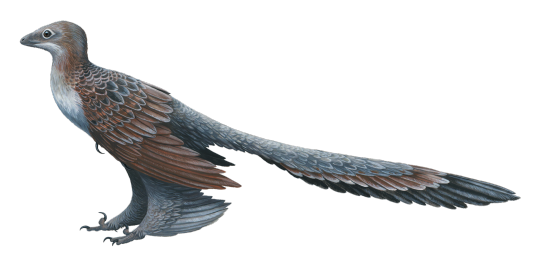
By Emily Willoughby, CC BY-SA 4.0
Behavior: Like Microraptor, Changyuraptor was probably capable of flight, making it one of the largest flying dinosaurs of the Mesozoic Era - with very few birds ever growing larger than it. It wouldn’t have been a particularly good flier though, only about as well as a chicken, taking off clumsily from the ground to go from area to area. It didn’t have enough strength in the chest and wing muscles to do much more than this, though it’s possible the hindlimb feathers would have allowed for some maneuvering in the air. It then could pounce on its prey, using its sickle claw to hold onto struggling animals before eating them.
More importantly; the wings, tail fan, and leg wings would have all been good display structures for Changyuraptor, which would have used them to communicate with other members of the species. These feathers would have signaled anger, a desire to mate, or danger, as feathers today are used by birds. It’s probable, then, that at least some fancy coloration may have been present on Changyuraptor to aid in the communication. Changyuraptor would have been a very active animal and most likely would have taken care of its young. In fact, it may have used its variety of wings and fans to help brood the nest.
Ecosystem: Changyuraptor lived in the Yixian Formation, a highly diverse ecosystem showcasing the evolution of birdie dinosaurs - like Changyuraptor - at the beginning of the Cretaceous period. A temperate, seasonal, and humid climate, it was much like the modern day northwestern Pacific Coast, though it would have seen snow on a regular basis, as well as notable dry seasons. It was a diverse coniferous forest, with a variety of flowering plants, ferns, horsetails, ginkgoes, cycads, seed ferns, and many others. Changyuraptor would have probably spent most of its time in the trees as well as on the ground, given its flight ability. There were a lot of freshwater lakes, and abundant volcanic eruptions.
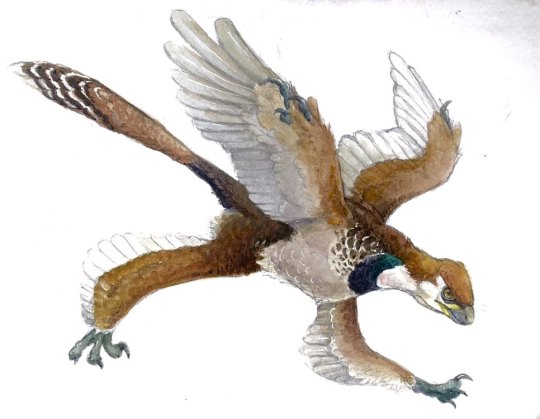
By Ripley Cook
Changyuraptor lived along so many other kinds of dinosaurs, it’s almost impossible to list them all. There were ankylosaurs like Liaoningosaurus and ornithopods like Bolong and Jinzhousaurus. There was the larger Compsognathid Sinosauropteryx, as well as many raptors in addition to Changyuraptor like the large Zhenyuanlong, Sinornithosaurus, and Tianyuraptor. There was also the Troodontid Jianianhualong, the seed eating protobird Jeholornis, smaller protobirds like Confuciusornis and Zhongornis, and the Anchiornithid Yixianosaurus. Opposite birds were there too like Dalingheornis and Shanweiniao, as well as near-birds like Archaeorhynchus, Eogranivora, Yanornis, Hongshanornis, and Longicrusavis. Non-dinosaurs like fish, amphibians, and lizards were also there; they along with mammals like Akidolestes, Sinobaatar, Sinodelphys, Chaoyangodens, and Eomaia would have been the primary prey of Changyuraptor. There were also Choristoderes like Hyphalosaurus and Monjurosuchus, as well as pterosaurs like Cathayopterus and Ningchengopterus. In short, a fascinating snapshot of Early Cretaceous life.
Other: Changyuraptor was closely related to - and preceded - Microraptor, one of the best known feathered dinosaurs; though we don’t know if it would have been colored like Microraptor, it’s possible it may have also had iridescent feathers like its later relative.
~ By Meig Dickson
Sources under the Cut
Amiot, R., X. Wang, Z. Zhou, X. X. Wang, E. Buffetaut, C. Lécuyer, Z. Ding, F. Fluteau, T. Hibino, N. Kusuhashi, J. Mo, V. Suteethorn, Y. Y. Wang, X. Xu, F. Zhang. 2011. Oxygen isotopes of East Asian dinosaurs reveal exceptionally cold Early Cretaceous climates. Proceedings of the National Academy of Sciences 108 (13): 5179 - 5183.
Benson, R.B.J. & Brussatte, S. (2012). Prehistoric Life. London: Dorling Kindersley. p. 332.
Choi, Charles (15 July 2014). "Bizarre Dinosaur Had 4 'Wings,' Long Tail Feathers". LiveScience.com. Retrieved 16 July 2014.
Gang Han; Luis M. Chiappe; Shu-An Ji; Michael Habib; Alan H. Turner; Anusuya Chinsamy; Xueling Liu & Lizhuo Han (15 July 2014). "A new raptorial dinosaur with exceptionally long feathering provides insights into dromaeosaurid flight performance". Nature Communications. 5: 4382.
Iacurci, Jenna (15 July 2014). "New Four-Winged Dinosaur Built for Flight". Nature World News. Retrieved 16 July 2014.
Larsson, Hans, Hone, David, Dececchi, T. Alexander, Sullivan, Corwin, Xu, Xing. "THE WINGED NON-AVIAN DINOSAUR MICRORAPTOR FED ON MAMMALS: IMPLICATIONS FOR THE JEHOL BIOTA ECOSYSTEM" "Program and Abstracts. 70th Anniversary Meeting Society of Vertebrate Paleontology October 2010" 114A.
Meng, F.X.; Gao, S.; Liu, X.M. (2008). “U-Pb zircon geochronology and geochemistry of volcanic rocks of the Yixian Formation in the Lingyuan area, western Liaoning, China”. Geological Bulletin of China. 27: 364–373.
Morgan, James (16 July 2014). "Four-winged dinosaur is 'biggest ever'". BBC News. Retrieved 16 July 2014.
Naish, Darren (2012). Planet Dinosaur: The Next Generation of Killer Dinosaurs. Firefly Books. p. 186.
Nicholas R. Longrich; David M. Martill; Brian Andres (2018). "Late Maastrichtian pterosaurs from North Africa and mass extinction of Pterosauria at the Cretaceous-Paleogene boundary". PLOS Biology. 16 (3): e2001663.
Pickrell, John (16 July 2014). "Four-winged dinosaur had record-breaking tail feathers". Australian Geographic Society. Retrieved 16 July 2014.
Wang, Y., S. Zheng, X. Yang, W. Zhang, Q. Ni. 2006. The biodiversity and palaeoclimate of confier floras from the Early Cretaceous deposits in western Liaoning, northeast China. International Symposium on Cretaceous Major Geological Events and Earth System: 56A.
Zhou, Z. 2006. Evolutionary radiation of the Jehol Biota: chronological and ecological perspectives. Geological Journal 41: 377-393.
#Changyuraptor#Changyuraptor yangi#Dromaeosaur#Raptor#Dinosaur#Bird#Birds#Dinosaurs#Feathered Dinosaurs#Paleontology#Prehistoric Life#Prehistory#Birblr#Palaeoblr#Factfile#Carnivore#Eurasia#Theropod Thursday#Cretaceous
264 notes
·
View notes
Photo
See, the thing is Ripley is used to being isolated. He said as much to Sullivan. When you’re chief, you don’t have many peers or friends. And it’s true. Being the Big Boss is isolating, especially in an all-consuming job. So for him, having this connection with Vic is probably the most liberating, energizing thing that’s happened to him in ages. He has a person! Someone to have dinner with and talk over his day with and have a physical connection with. So for him, she’s a bright ray of light.
But for Vic, who has a team of peers she loves and respects and socializes with, having to keep this secret is the opposite of light. She’s stepping into his isolation and it’s super jarring for her.
Keeping the relationship a secret is no big deal with Lucas, because he doesn’t have anyone to tell but his sister. Keeping it a secret for Vic is a huge deal because she’s used to her support system and the liberation that comes with being able to lean on people. So yeah, her fully acquiescing to having to hide and stay a secret? That’s her choosing him and his isolation over her light, showing just how much she’s willing to sacrifice to be with him.




Look how far Vic has come in this relationship. She hates that they have to hide because she has feelings for him and wants to be able to show them. My heart broke when she said: but we have to.
#clearly i have thoughts about this#victoria hughes: sassmaster general#lucas ripley: details guy#they are precious and i love them#station 19#les writes the things
194 notes
·
View notes